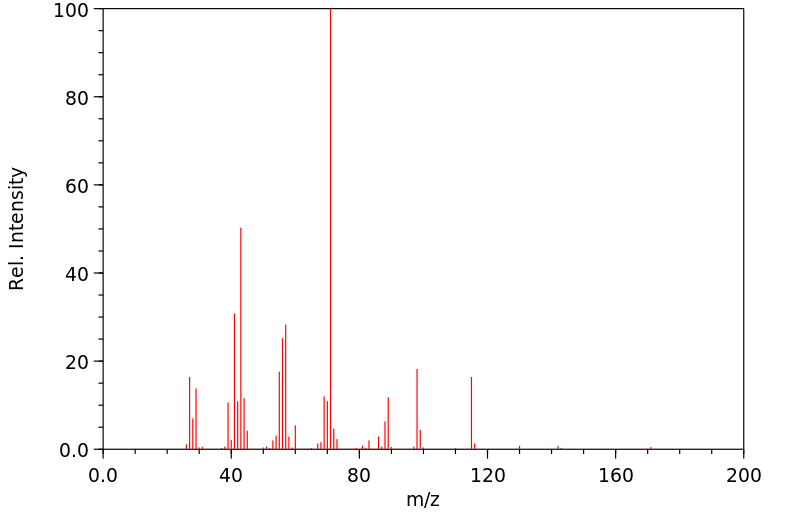庚烷-2-基丁酸酯 | 39026-94-3
中文名称
庚烷-2-基丁酸酯
中文别名
——
英文名称
1-methylhexyl butanoate
英文别名
heptan-2-yl butanoate;2-heptyl butanoate;butyric acid-(1-methyl-hexyl ester);Buttersaeure-(1-methyl-hexylester);butanoic acid 1-methylhexyl ester;n-Buttersaeureheptanol-(2)-ester;2-Heptyl butyrate
CAS
39026-94-3
化学式
C11H22O2
mdl
MFCD06796189
分子量
186.294
InChiKey
GTKUPJHQSAPWLL-UHFFFAOYSA-N
BEILSTEIN
——
EINECS
——
-
物化性质
-
计算性质
-
ADMET
-
安全信息
-
SDS
-
制备方法与用途
-
上下游信息
-
文献信息
-
表征谱图
-
同类化合物
-
相关功能分类
-
相关结构分类
物化性质
-
熔点:-57.5°C (estimate)
-
沸点:220.8°C (estimate)
-
密度:0.8726 (estimate)
-
LogP:4.24
-
物理描述:Colourless liquid
-
溶解度:insoluble in water; soluble in fats
-
折光率:1.413-1.417
-
保留指数:1230;1194;1199;1194;1198;1194;1197
计算性质
-
辛醇/水分配系数(LogP):3.7
-
重原子数:13
-
可旋转键数:8
-
环数:0.0
-
sp3杂化的碳原子比例:0.909
-
拓扑面积:26.3
-
氢给体数:0
-
氢受体数:2
SDS
上下游信息
反应信息
-
作为反应物:描述:庚烷-2-基丁酸酯 在 Candida antarctica lipase B immobilized on acrylic resin catalyst 作用下, 反应 8.0h, 生成 (R)-(-)-2-庚醇 、 (S)-2-heptyl butanoate 、 (R)-2-heptyl butanoate参考文献:名称:脂肪酶催化动力学拆分制备百香果型典型的2-烷基酯对映体摘要:研究了通过脂肪酶催化动力学拆分制备仲醇2-戊醇,2-庚醇和2-壬醇的酯对映体(乙酸,丁酸酯,己酸酯和辛酸酯)。通过庚烷(2,3-di- O -methyl-6)的毛细管气相色谱法,对这些百香果类典型的2-烷基酯的同源系列进行了追踪,考察了市售酶制剂催化的酯化和水解反应的转化率和立体化学过程。- ø -叔丁基二)-β环糊精作为手性固定相。开发了一种通过脂肪酶催化的酯化反应制备酯对映体的有效方法:光学纯(R通过用对映选择性南极假丝酵母脂肪酶B(固定化)作为催化剂将外消旋醇酯化,可得到)-2-烷基酯(ee> 99.9%)。随后使用来自假丝酵母的脂肪酶将未反应的醇酯化,得到光学富集的(S)-酯(ee> 81.4%)。通过使用硅胶和氧化铝(碱性)的混合物的液体固体色谱法分离产物,得到高化学纯度和产率(> 40mol%)。DOI:10.1021/jf100432s
-
作为产物:描述:2-庚醇 在 水 、 disodium;carbonate 、 丁酸酐 、 Sodium sulfate-III 、 crude residue 作用下, 以 丁酸酐 为溶剂, 85.0~160.0 ℃ 、1.42 MPa 条件下, 反应 5.5h, 以provided 1-methylhexyl butyrate (85-110°/78-80 mm Hg, 85% yield)的产率得到庚烷-2-基丁酸酯参考文献:名称:Methods for using 1-methylbutyl and 1-methylhexyl esters as flavoring摘要:本发明涉及一种由公式表示的纯化调味剂:CH.sub.3 (CH.sub.2).sub.n CH(CH.sub.3)OCOR,其中n为2或4,R为具有1至5个碳原子的低级烷基基团。该调味剂可用于各种可食用载体,如嚼胶组合物、硬质和软质糖果、乳制品、果汁产品等。本发明还涉及制备和使用该调味剂及其可食用产品的方法。公开号:US05993879A1
文献信息
-
Enantioselective Analysis of Secondary Alcohols and Their Esters in Purple and Yellow Passion Fruits作者:Hedwig Strohalm、Márta Dregus、Astrid Wahl、Karl-Heinz EngelDOI:10.1021/jf072464n日期:2007.12.1The enantiomeric compositions of the acetates, butanoates, hexanoates, and octanoates of the secondary alcohols 2-pentanol, 2-heptanol, and 2-nonanol were determined in yellow (Passiflora edulis f. flavicarpa) and purple (Passiflora edulis Sims) passion fruits. The compounds were isolated by means of simultaneous distillation-extraction. Enantiodifferentiation was performed via multidimensional gas chromatography using heptakis(2,3-di-O-methyl-6-O-tert-butyldimethylsilyl)-beta-cyclodextrin as chiral stationary phase. The series of homologous 2-alkyl esters, which are typical constituents of purple passion fruits, were shown to be present as nearly optically pure (R)-enantiomers. The proportions of the (S)-enantiomers varied in different batches and were dependent on the alcohol moieties of the esters. For minor amounts of esters detected in yellow fruits, the (R)-enantiomers were also dominating. However, the enantiomeric excesses were significantly lower than in the purple variety. Enantioselective analysis of the free alcohols revealed that 2-heptanol exhibited opposite configurations in purple and yellow passion fruits. A similar phenomenon was observed for 2-pentanol, which was present in the yellow fruits as a nearly racemic mixture. Data determined in extracts obtained by other techniques (liquid-liquid extraction, vacuum headspace technique) showed that the isolation procedure had no significant impact on the enantiomeric ratios.
-
Enantioselective transesterification catalysis by nanosized serine protease subtilisin Carlsberg particles in tetrahydrofuran作者:Betzaida Castillo、Yamixa Delgado、Gabriel Barletta、Kai GriebenowDOI:10.1016/j.tet.2010.01.053日期:2010.3Enzyme catalysis in organic solvents is a powerful tool for stereo-selective synthesis but the enantioselectivity is still hard to pi edict To overcome this obstacle. we employed a nanoparticulate formulation of subtilisin Carlsberg (SC) and designed a series of 14 structurally related racemic alcohols They were employed in the model transesterification reaction with vinyl butyrate and the enantioselectivities were determined. In general. short alcohol side chains led to low enantioselectivties, while larger and bulky side chains caused better discrimination of the enantiomers by the enzyme With several bulky substrates high enantioselectivities with E>100 were obtained Computational modeling highlighted that key to high enantioselectivity is the discrimination of the R and S substrates by the sole hydrophobic binding pocket based on their size and bulkiness While bulky S enantiomer side chains could be accommodated within the binding pocket, bulky R enantiomer side chains could not However, when also the S enantiomer side chain becomes too large and does not fit into the binding pocket anymore. enantioselectivity accordingly drops (C) 2010 Elsevier Ltd All rights reserved
-
Iron Perchlorate on Silica Gel as Multi-purpose Reagent for Catalysis of Closure and Rupture of Carbon-Oxygen Bond in Epoxides, Alcohols, and Esters作者:P. Salechi、M. M. Khodaei、S. B. Ghareghani、A. R. MotlaghDOI:10.1023/b:rujo.0000003154.92028.84日期:2003.6Aliphatic alcohols and water in the presence of catalytic amounts of Fe3+ ion introduced as iron(Ill) perchlorate on silica gel carrier perform efficient regiospecific opening of an epoxy ring. Carbon acids esterification with various type alcohols was carried out using the system Fe(ClO4)(3)-silica gel in dichloromethane under conditions excluding solvolysis. Acetylation and formylation of alcohols was performed by efficient transesterification with ethyl acetate and ethyl formate.
-
Hogan, V F; O'Hagan, D; Sanvoisin, J, Indian Journal of Chemistry - Section B Organic and Medicinal Chemistry, 1992, vol. 31, # 12, p. 883 - 885作者:Hogan, V F、O'Hagan, D、Sanvoisin, JDOI:——日期:——
-
US5993879A申请人:——公开号:US5993879A公开(公告)日:1999-11-30
表征谱图
-
氢谱1HNMR
-
质谱MS
-
碳谱13CNMR
-
红外IR
-
拉曼Raman
-
峰位数据
-
峰位匹配
-
表征信息
同类化合物
(±)17,18-二HETE
(±)-辛酰肉碱氯化物
(Z)-5-辛烯甲酯
(Z)-4-辛烯酸
(R)-甲羟戊酸锂盐
(R)-普鲁前列素,游离酸
(R,R)-半乳糖苷
(E)-4-庚烯酸
(E)-4-壬烯酸
(E)-4-十一烯酸
(9Z,12E)-十八烷二烯酸甲酯
(6E)-8-甲基--6-壬烯酸甲基酯-d3
(3R,6S)-rel-8-[2-(3-呋喃基)-1,3-二氧戊环-2-基]-3-羟基-2,6-二甲基-4-辛酮
龙胆二糖
黑曲霉二糖
黄质霉素
麦芽酮糖一水合物
麦芽糖醇
麦芽糖酸
麦芽糖基蔗糖
麦芽糖一水合物
麦芽糖
鳄梨油酸乙酯
鲸蜡醇蓖麻油酸酯
鲸蜡醇油酸酯
鲸蜡硬脂醇硬脂酸酯
鲸蜡烯酸脂
鲸蜡基花生醇
鲫鱼酸
鲁比前列素
鲁比前列素
高级烷基C16-18-醇
高甲羟戊酸
高效氯氰菊酯
高-gamma-亚油酸
马来酸烯丙酯
马来酸氢异丙酯
马来酸氢异丁酯
马来酸氢丙酯
马来酸氢1-[2-(2-羟基乙氧基)乙基]酯
马来酸单乙酯
马来酸单丁酯
马来酸二辛酯
马来酸二癸酯
马来酸二甲酯
马来酸二烯丙酯
马来酸二正丙酯
马来酸二戊基酯
马来酸二异壬酯
马来酸二异丙酯







